VMPK is a MIDI-powered application that lets you turn your Linux systems into a virtual piano, thus allowing you to test, compose, or practice music. It is a lightweight tool that doesn’t care about the specs of your device and allows you to use a virtual piano on even older devices. Furthermore, it supports multiple platforms like Windows, macOS, BSD, and so on. When it comes to Linux, you can easily install it on a number of distributions. There are several methods to install VMPK on Linux. We have created the following guide to help our readers install VMPK without any issues.
What Is VMPK?
VMPK or virtual MIDI piano keyboard is a versatile app that allows you to use your computer as a digital piano, powered by MIDI. The app emulates a piano keyboard on the computer screen that you can use to play musical notes with the help of either your mouse or your keyboard. Thus, it is invaluable for any musician, aspiring or professional. It is equally helpful for music production and can easily serve as an alternative to a physical piano.
You can also use VMPK to input music notes, test your MIDI setup, or simply practice your piano skills. There are also functions such as velocity control, channel selection, and program changes that can further help your music production needs. Moreover, the app is compatible with other MIDI software so you can also use it to connect to other DAWs, synthesizers, and MIDI controllers.

Features
Below are a few features of VMPK:
Works As A MIDI Controller
VMPK can be seen as a fully functional MIDI controller that works in real time, allowing you to input music notes through your keyboard or mouse. The app offers velocity sensitivity to allow for more control over your playing, thus making it much more dynamic than similar apps. You can use it to control each and every note that you input, as well as how to trigger them. Furthermore, you can map the keys on your keyboard to get a fully custom experience. Lastly, different channels can help you select and change your input based on the connected hardware.
Fully Customizable
Being open source, the app is fully customizable and offers a very user-friendly UI that can serve the needs of a variety of users. Not only can you adjust the number of visible keys on the virtual piano, but also add different color schemes. You can also use a full 88-key piano layout using VMPK. Users can also add labels to make the layout more personalized. Other than that, you can still resize the window and make the app accessible on various displays.
Advanced Control
You can exert a huge amount of control on your digital instrument, simply by using VMPK. The app uses a basic note input, that supports both pitch bend and modulation, allowing users more freedom. You can also use VMPK to program the MIDI controller to reflect any changes accordingly. The SysEx message makes it much more suitable for complex setups, worthy of professional music production.
Cross-Platform Support
You can always use VMPK on different platforms like Windows, macOS, and Linux. Furthermore, the app supports integration with other music software and hardware. Also, you get ALSA MIDI and JACK MIDI support on Linux, CoreMIDI on macOS, and Windows MM on Windows, allowing the app to be versatile.
Dependencies
- Qt v5.1+
- -devel package
- Drumstick RT
- CMake
- GCC
- C++
How To Install VMPK On Linux?
When it comes to installing VMPK on Linux, there are a number of methods you can use, such as using the official package repositories or building it from source. Thus, all you need to do is follow the steps detailed below:
Method 1. Install VMPK on Linux Using Official Package Managers
You can install VMPK on various Linux distros using the native package managers by simply using the following commands:
Ubuntu/Debian
sudo apt update
sudo apt install vmpkFedora
sudo dnf install vmpkRHEL/CentOS
sudo yum install epel-release
sudo yum install vmpkArch Linux
sudo pacman -S vmpkOpenSUSE
sudo zypper install vmpkLinux Mint
sudo apt update
sudo apt install vmpkVoid Linux
sudo xbps-install -S vmpkAlt Linux
sudo apt-get update
sudo apt-get install vmpkSolus
sudo eopkg install vmpkMageia
sudo urpmi vmpkFreeBSD
pkg install vmpkOpenBSD
pkg_add vmpkDragonFly BSD
pkg install vmpkGentoo
emerge media-sound/vmpkNixOS
nix-env -iA nixpkgs.vmpkMethod 2. Install VMPK via Flatpak
Installing Flatpak on a device allows you to install VMPK via the Flathub repository. Flatpak is a universal package manager that can run on various Linux distributions:
Step 1. Start by installing Flatpak:
sudo apt install flatpakStep 2. Now, Add the Flathub repository:
flatpak remote-add --if-not-exists flathub https://flathub.org/repo/flathub.flatpakrepoStep 3. Finally, install VMPK using Flathub:
flatpak install flathub net.sourceforge.VMPKMethod 3. Using Snap To Install VMPK
Step 1. First, install Snap:
sudo apt install snapdStep 2. Now, enable the Snap service:
sudo systemctl enable --now snapd.socketStep 3. Finish installing VMPK via Snap:
sudo snap install vmpkMethod 4. Install VMPK On Linux Using AppImage
Step 1. First, download the latest VPMK AppImage file from the official website.
Step 2. Now, make the file executable:
chmod +x VMPK-*.AppImageStep 3. Finally, run VMPK:
./VMPK-*.AppImageMethod 5. Compile VMPK From Source
You can build VMPK from source. This lets you customize the app as per your needs and is suitable for developers and advanced users.
Step 1. First, install the required development tools:
Debian/Ubuntu
sudo apt install build-essential cmake qt5-qmake qtbase5-dev qttools5-dev-tools libasound2-dev libjack-jackd2-dev libpulse-devFedora
sudo dnf install gcc-c++ make cmake qt5-qtbase-devel qt5-qttools-devel alsa-lib-devel jack-audio-connection-kit-devel pulseaudio-libs-develArch Linux
sudo pacman -S base-devel cmake qt5-base qt5-tools alsa-lib jack pulseaudioStep 2. Now, download the source file from VMPK Sourceforge page and unpack it.
Step 2.1- Alternatively, you can clone the VMPK GitHub repo:
git clone https://github.com/vmpk/vmpk.git
cd vmpkStep 3. Now, start the build:
mkdir build && cd buildStep 4. Finally, compile and install the app:
cmake ..
make
sudo make install